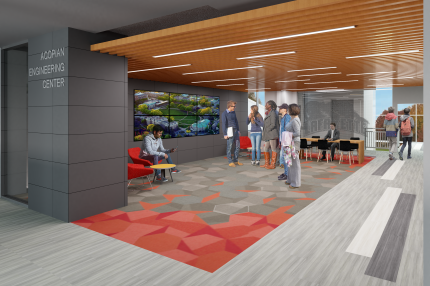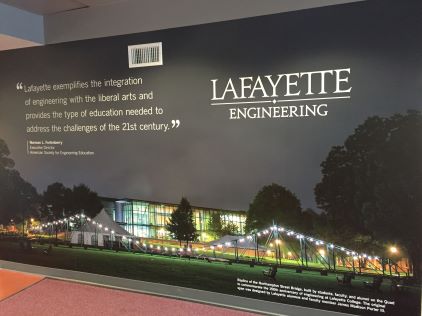Along with fifth-floor expansion, future phases will include remodeled entryway equipped with digital information wall and leading-edge laboratories in robotics and bioengineering
By Scott Hummel, William A. Jeffers Director of the Engineering Division
A highly collaborative organization or team is more than just the sum of its parts; it can respond better to changing opportunities and challenges, is able to leverage talent more effectively by incorporating more varied perspectives, uses resources more effectively, and is more able to meet stakeholder needs. These benefits are every bit as applicable in engineering education as they are in a business or nonprofit environment.
Lafayette’s engineering programs are advancing the concepts of enhanced collaboration in a variety of ways. At the course level, students are working on cross-functional teams from first-year courses through senior-year capstone design projects, ranging from electric cars to biotechnology.

Lafayette has recently made a major step in collaborative education through its new engineering degree program. This new Bachelor of Science (B.S.) program focuses on systems analysis methods by examining the intersections of traditional disciplines. Students may choose among bioengineering, robotics, environmental engineering, and energy. Each of these topics spans multiple traditional fields and only through collaboration can they be thoroughly explored.
In addition to courses and programmatic endeavors, the engineering facilities also need to foster collaboration. Having spaces that naturally bring people together is an essential ingredient in creating intellectual unions. These spaces must be inviting, inclusive, and reflective of a top-ranked engineering program. With these goals in mind, extensive renovations are taking place and are planned in Acopian Engineering Center.
The first phase of the renovation project, completed during summer 2019, includes three new computer labs, three collaboration spaces, and two multidisciplinary laboratories. This phase serves as the prototype for future phases and incorporates energy-efficient LED lighting, modern aesthetics, and improved restroom facilities.
Phase two will bring a dramatic change to Acopian Engineering Center with the expansion of the fifth floor. Currently, the fifth floor does not extend to the east side of the facility. Through a generous gift from Walter Scott ’59, a 4,000-square-foot addition will be constructed on the Markle Hall side. This addition will add three high-tech classrooms and a glass collaboration center.

Along with the fifth-floor expansion, future phases will include a remodeled entryway equipped with a digital information wall and leading-edge laboratories in robotics and bioengineering. Casual study areas with natural light will be built throughout the facility to create inviting and open areas for students to learn and collaborate. Design elements from the Rockwell Center will flow into Acopian Engineering Center. These architectural elements, along with the physical connection between the two buildings, will provide seamless integration.
The renovation and expansion represent the first facility-wide construction project since the 2002 renovation made possible by the Acopian family. The gift from Sarkis Acopian ’51 and Bobbye Acopian significantly upgraded the facility to a modern engineering education center and positioned Lafayette engineering to make these next steps in engineering education.

